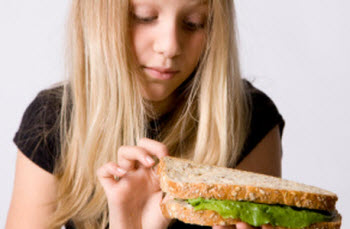 The family is seated at the perfectly set table, the dinner you lovingly (and laboriously) prepared from scratch is carefully placed in front of the children. Aaahhh.
The family is seated at the perfectly set table, the dinner you lovingly (and laboriously) prepared from scratch is carefully placed in front of the children. Aaahhh.
But before you can savor the perfect parent moment, you hear it:
“This smells gross.”
Or, “I’m not eating that!”
Or perhaps the most annoying of them all, “Eewwwww.”
Does this sound like a familiar scene?
Many parents struggle to feed their picky eaters and often associate the issue with the child’s personality. Interestingly, many causes of picky eating actually have nutritional roots.
Zinc deficiency
For example, a zinc deficiency can make all foods taste bad or bland. When zinc is lacking in a child’s diet, his sense of smell is reduced and food tastes unappetizing, according to certified nutrition consultant Julie Matthews.
Texture can then become an even bigger factor. “If you couldn’t taste flavor, mashed potatoes would taste like bland mush,” Mathews says.
Solution: Pumpkin seeds are an excellent source of zinc and one that Matthews often recommends for children. Peanuts and roast beef are two other good options.
Insufficient stomach acid
Similarly, kids who refuse to eat meat could be suffering from a deficiency in the stomach acid which is required to break down and digest protein.
“The stomach requires an acidic environment to properly digest protein. If the Ph balance in the stomach is too alkaline, the food will not be digested and will linger in the stomach, causing discomfort,” says Seattle-based Nutritional Therapy Practitioner Andrea Dahlman. “Many children begin to associate this feeling with eating meat and start to avoid meat and protein choices.”
Solution: To reverse this trend, Dahlman suggests administering a tablespoon of apple cigar vinegar mixed with three ounces of water 30 minutes prior to the meal to help increase stomach acid production.
 Chemical addictions
Chemical addictions
Another key trigger for picky eaters is “addictions” to the chemicals used in food, including artificial colors, artificial flavors and other additives like MSG.
Just like other addictions to caffeine, nicotine, alcohol and other drugs, these chemical additives can create a craving in the body that can only be quelled by consuming more of the offending substance.
For example, children who will only eat a specific brand, like McDonald’s chicken nuggets or Kraft macaroni and cheese, are often sensitized to certain chemicals used in those brands. Kids will then reject competing brands if they don't incorporate the same chemicals, as the substitute product won’t trigger the same stimulatory response.
Solution: Try slowly working in homemade, healthier versions of your kids’ favorite addictive foods. Start slowly and involve them in the food preparation — homemade mac and cheese becomes more appealing when the kids have a hand in cooking it.
Food intolerances
Finally, if kids are not able to properly digest wheat and dairy, these undigested food particles can enter the blood stream and create a drug-like effect in the brain. This feel-good response then triggers greater cravings for wheat and dairy foods. Yeast overgrowth can also activate cravings for carbohydrates and sugar.
Solution: If you suspect your child has a food intolerance, consult a specialist and have him tested, or ask your doctor if incorporating an elimination diet to test out the theory would make sense.
Top 10 Tips for Converting Picky Eaters
1. Eliminate food intolerances. These foods are stressing your child’s system, making it harder to digest and heal. You give the body a break when these foods are removed.
2. Get creative with taste, texture, and visual presentation. With picky eaters, texture goes a long way. Very often children expand their diet with some creativity and effort in the kitchen, such as dipping sauces made from colorful veggies. [Check out our adventurous eater series for more ideas.]
3. Remove refined and processed ingredients. As the addictive foods are removed, children will begin to eat a larger variety of foods.
4. Create a positive first impression of new foods. When you introduce a new food, make sure it tastes good, even if it means deep-frying sweet potatoes to make French fries, making sweet zucchini bread, or coating fish in almonds and drowning it with butter. Once your child thinks he likes “fish,” it will be easier getting him to eat it next time.
5. Let them pick out their own fruits and vegetables. Letting kids select their own produce at the store or farmers market (or grow it themselves in a garden) makes them more invested in liking it.
6. Be honest. If you hide veggies in your kids’ food, tell them about it either while they are eating it, or maybe just afterward. They need to know the hidden ingredient isn’t so horrifying. Plus, if when they turn 18 they still think they’ve never eaten broccoli — because it’s always been hidden in their food — where is that going to get you?
7. Involve them in selecting dinner or breakfast recipes and helping you cook the meal. Even kids as young as 1 or 2 are great at stirring! Most kids will at least have a taste if they helped to make the meal.
8. Enforce a “one-bite rule.” Make kids try a food and remind them that it won’t hurt them if it tastes bad. Also allow them to wash it down with their drink as opposed to spitting it out. It can take a dozen or more times for a child to realize he might like a new food.
9. Do not pressure or upset your kids too much over trying a new food. You don’t want them to have any negative feelings toward food or mealtime. There is a sweet spot somewhere between not giving up easily and not pushing them too hard. The “one-bite rule” is a happy medium.
10. For resistant kids, only put one new food on their plate at a time, along with other food that you already know they like.
Jodi Cohen is a Seattle-based Nutritional Therapist. She enjoys running, yoga, writing and time spent with her two young children. To learn more visit her at Vibrant Roots.









